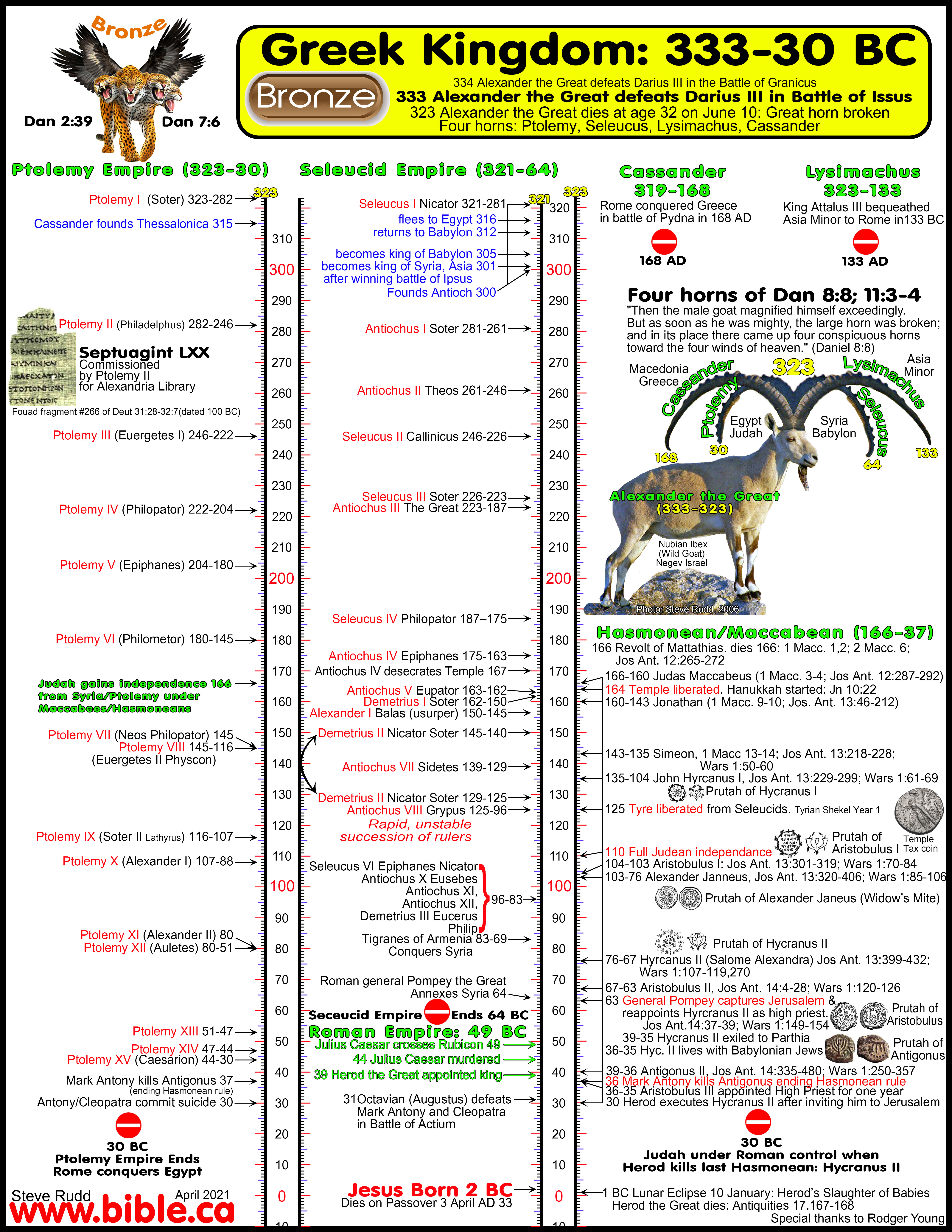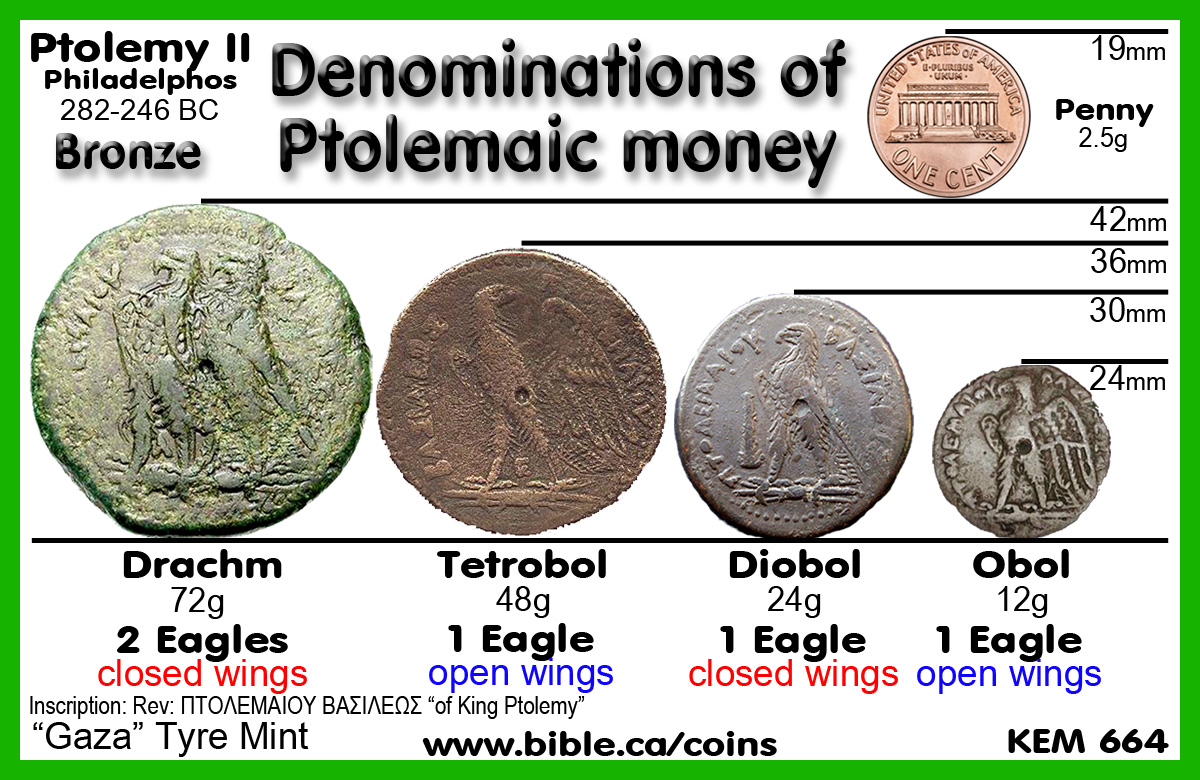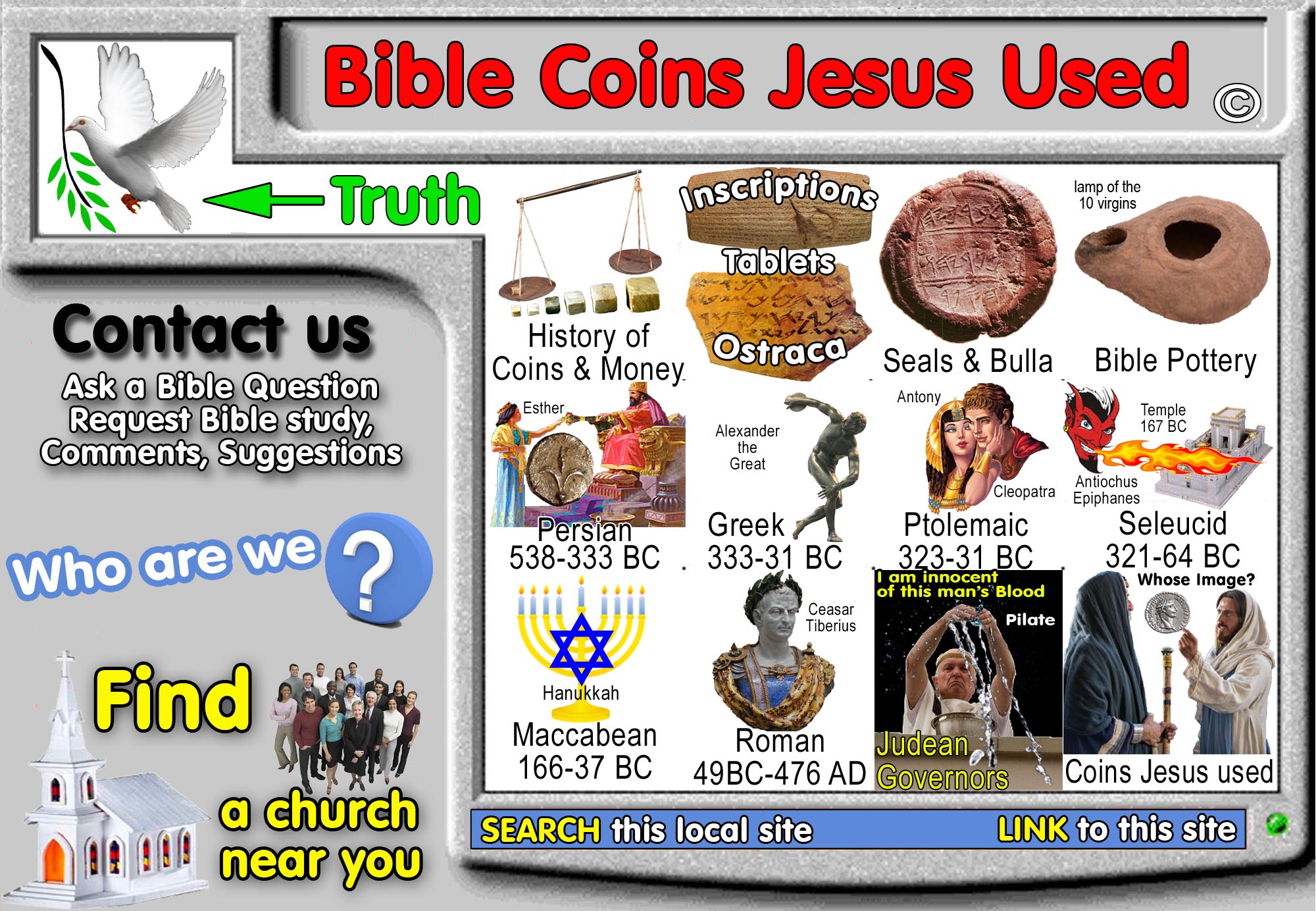Greek Empire, Hellenistic Coins. Macedonian era: 333-302 BC
|
GREEK EMPIRE COIN PAGES (333-31 BC) |
|||
|
333-302 BC |
323-31 BC |
321-64 BC |
166-37 BC |
|
|
|||
Introduction:
- Alexander the Great conquers the world in a stunning and unique series of victories:
- In 334 BC Alexander the Great defeats Darius III in the Battle of Granicus
- In 333 BC Alexander the Great defeats Darius III in Battle of Issus
- In 323 BC Alexander the Great dies at age 32 on June 10: The Great broken horn of Daniel. After Alexander the Great died, his kingdom split into four kingdoms just as Daniel had prophesied:
- "After you there will arise another kingdom inferior to you, then another third kingdom of bronze, which will rule over all the earth." (Daniel 2:39)
- "After this I kept looking, and behold, another one,
like a leopard, which had on its back four wings of a bird; the beast
also had four heads, and dominion was given to it." (Daniel 7:6)
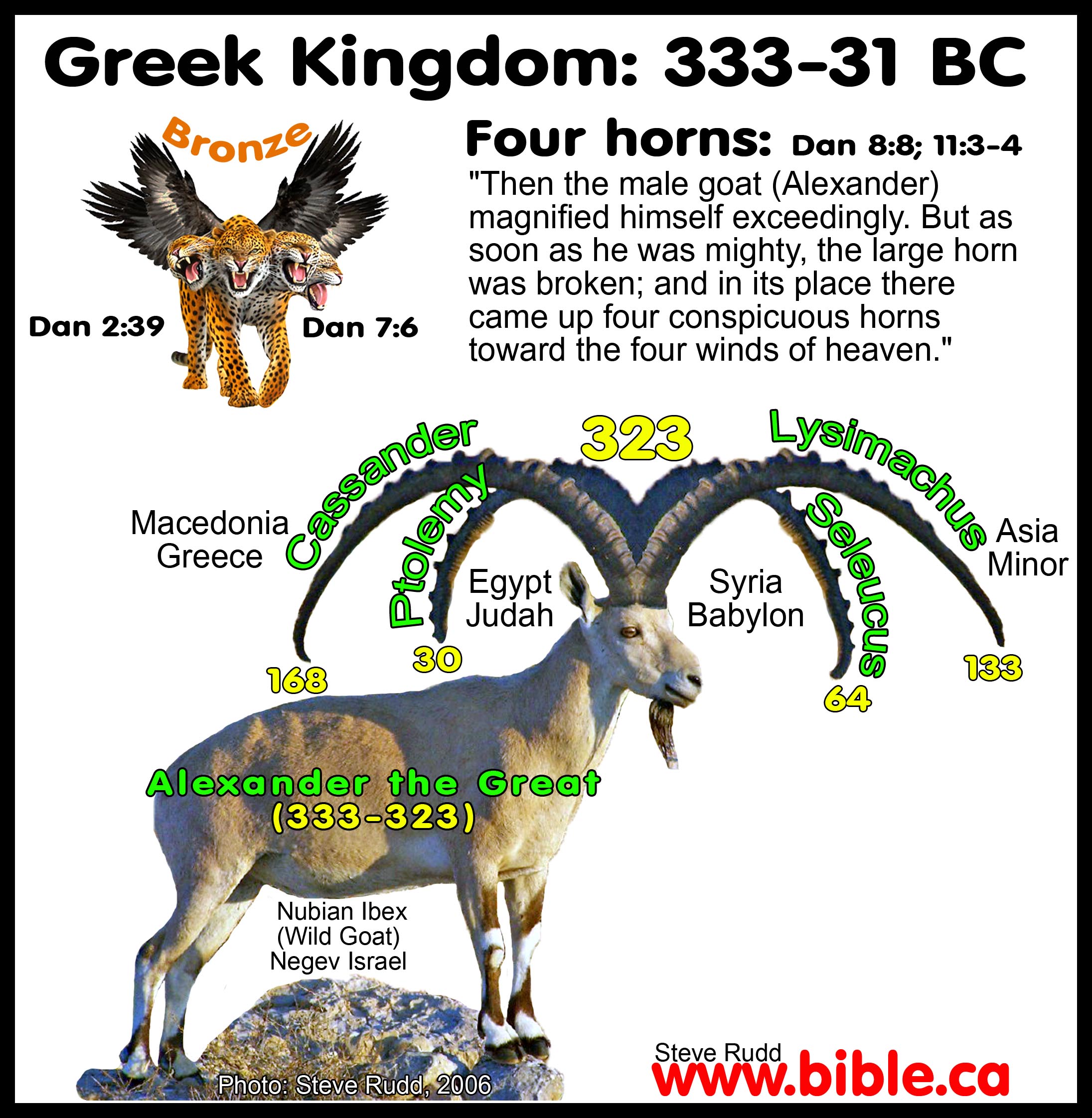
- Four horns of Dan 8:8; 11:3-4
- "Then the male goat magnified himself exceedingly. But as soon as he was mighty, the large horn was broken; and in its place there came up four conspicuous horns toward the four winds of heaven." (Daniel 8:8)
- "“And a mighty king will arise, and he will rule with great authority and do as he pleases. “But as soon as he has arisen, his kingdom will be broken up and parceled out toward the four points of the compass, though not to his own descendants, nor according to his authority which he wielded, for his sovereignty will be uprooted and given to others besides them." (Daniel 11:3–4)
- Four "horns" empires after Alexander the Great:
- Ptolemy Empire (323-31 BC)
- Area of modern Egypt
- Ptolemy Empire Ends when Rome conquers Egypt in 31 BC
- Antony/Cleopatra commit suicide 30 extincting the Ptolemy empire.
- Seleucid Empire (321-64 BC)
- Area of Modern Israel, Syria, Turkey
- Cassander (319-168 BC)
- Area of Modern Greece.
- Cassander founds Thessalonica 315 BC
- Rome conquered Greece in battle of Pydna in 168 AD)
- Lysimachus (323-133 BC)
- Area of modern Asia Minor.
- King Attalus III bequeathed Asia Minor to Rome in 133 BC
I. Greek kingdom period after Alexander the Great: 323-31 BC
|
Greek kingdom period: 323-31 BC |
||
|
Ptolemaic Empire kings |
Seleucid Empire kings |
Hasmonean/Maccabean kings 166-37 BC |
|
1. Ptolemy I (Soter) 323-282 BC 2. Ptolemy II (Philadelphus) 282-246 BC 3. Ptolemy III (Euergetes I) 246-222 BC 4. Ptolemy IV (Philopator) 222-204 BC 5. Ptolemy V (Epiphanes) 204-180 BC 6. Ptolemy VI (Philometor) 180-145 BC 7. Ptolemy VII (Neos Philopator) 145 BC 8. Ptolemy VIII (Euergetes II Physcon) 145-116 BC 9. Ptolemy IX (Soter II Lathyrus) 116-107 BC 10. Ptolemy X (Alexander I) 107-88 BC 11. Ptolemy XI (Alexander II) 80 BC 12. Ptolemy XII (Auletes) 80-51 BC 13. Ptolemy XIV 47-44 BC 14. Ptolemy XV (Caesarion) 44-30 BC Mark Antony kills Antigonus in 37 BC ending the Ptolemaic empire. |
1. Seleucus I Nicator 321-281 BC 2. Antiochus I Soter 281-261 BC 3. Antiochus II Theos 261-246 BC 4. Seleucus II Callinicus 246-226 BC 5. Seleucus III Soter 226-223 BC 6. Antiochus III The Great 223-187 BC 7. Seleucus IV Philopator 187–175 BC 8. Antiochus IV Epiphanes 175-163 BC 9. Antiochus IV desecrates Temple 167 BC 10. Antiochus V Eupator 163-162 BC 11. Demetrius I Soter 162-150 BC 12. Alexander I Balas (usurper) 150-145 BC 13. Demetrius II Nicator Soter 145-140 BC 14. Antiochus VII Sidetes 139-129 BC 15. Demetrius II Nicator Soter 129-125 BC 16. Antiochus VIII Grypus 125-96 BC 17. Rapid, unstable succession of rulers 96-83 18. Seleucus VI Epiphanes Nicator 19. Antiochus X Eusebes 20. Antiochus XI 21. Antiochus XI, 22. Demetrius III Eucerus 23. Philip 24. Tigranes of Armenia Conquers Syria 83-69 BC Roman general Pompey the Great Annexes Syria extincting the Seleucid empire in 64 BC |
1. Revolt of Mattathias: 166 BC 2. Judas Maccabeus: 166-160 BC 3. Jonathan: 160-143 BC 4. Simeon: 143-135 BC 5. John Hyrcanus I: 135-104 BC 6. Tyre liberated from Seleucids: 125 BC 7. Full Judean independence: 110 BC 8. Aristobulus I: 104-103 BC 9. Alexander Janneus: 103-76 BC 10. Hyrcanus II (Salome Alexandra): 76-67 BC 11. Aristobulus II: 67-63 BC 12. General Pompey captures Jerusalem and reappoints Hyrcranus II as high priest: 63 BC 13. Hycranus II exiled to Parthia: 40-36 BC 14. Antigonus II: 40-37 BC 15. Hycranus II lives with Babylonian Jews: 35 BC 16. Mark Antony kills Antigonus ending Hasmonean rule: 37 BC 17. Aristobulus III briefly appointed High Priest: 37 BC 18. Herod executes Hycranus II after inviting him to Jerusalem: 30 BC Judah under Roman control when Herod kills last Hasmonean (Hycranus II) in 30 BC |
|
Roman Empire rules entire world in 31 BC |
||
II. Denominations, diameters and weights of Ptolemaic and Greek coins who used the same system
- The early Macedonian era of Alexander the Great (333-302 BC) and the Ptolemaic Empire (323-21 BC) used the same money system of weights and coins.
- There were hundreds of coins produced during the Ptolemaic era of many varieties.
- During the earliest years of the empire, Ptolemy II (282-246 BC) for example produced a series of coin denominations in gold, silver and bronze.
- The same sets of coins were manufactured in up to four different mint cities: Sidon, Ptolemais, "Gaza" Tyre and Alexandria.
- Below is the series of coins produced at the Gaza "Tyre" mint.
- Notice the sequence of eagle motifs that progress large to small. This progression in size, weight and logical pictorial diagrams of eagles made the money easy to use and remember their value.
|
Prutah (Plural Prutot) |
1 prutah = 1 Quadran 2 lepta = 1 prutah 64 prutot = 1 denarii/drachma 256 prutot = 1 shekel |
|
Greek, Ptolemaic |
|
Half-prutah (plural half-prutot) |
1 half-prutah = 1 letpa 2 half-prutah - prutah 128 half-prutah = 1 drachma/denarii |
|
Greek, Ptolemaic |
|
Dekadrachm |
10 drachmae |
43 grams |
Greek, Ptolemaic |
|
Tetradrachm |
4 tetradrachm = 1 drachma 2 tetradrachm = 1 mina |
17.2 grams |
Greek, Ptolemaic |
|
Didrachm |
2 drachmae |
8.6 grams |
Greek, Ptolemaic |
|
Drachma (Plural drachmas) |
4 drachma = 1 Tyrian shekel 6000 drachmas = 1 talent 1 dinarii = 1 drachma 192 prutot = 1 denarius |
4.3 grams |
Greek, Ptolemaic |
|
Drachma |
6 obols |
4.3 grams |
Greek, Ptolemaic |
|
Tetrobol |
4 obols |
2.85 grams |
Greek, Ptolemaic |
|
Triobol |
3 obols |
2.15 grams |
Greek, Ptolemaic |
|
Diobol |
2 obols |
1.43 grams |
Greek, Ptolemaic |
|
Obol (Plural Obols) |
6 obols = 1 drachma 24 Obols = 1 tetradrachm 4 tetartemoria |
0.72 grams |
Greek, Ptolemaic |
|
Half-obol (plural Half-obols) |
12 Half-obols = 1 drachma 2 half-obols = 1 Obol |
|
Greek, Ptolemaic |
|
Lepta (Plural Lepton) |
1 letpa = 1 half-prutah 2 lepton = 1 quadran/prutah 7 lepton = 1 cholkos 128 lepton = 1 drachma/denarii |
|
Greek, Ptolemaic Widow gave two lepta (1 Prutot of Alexander Jannaeus) |
|
Quarter-obol |
24 quarter-obols = 1 drachma 4 quarter-obols = 1 Obol |
|
Greek,Ptolemaic |
|
Tritartemorion |
3 tetartemoria |
0.54 grams |
Greek, Ptolemaic |
|
Hemiobol |
2 tetartemoria |
0.36 grams |
Greek, Ptolemaic |
|
Trihemitetartemorion |
3/2 tetartemorion |
0.27 grams |
Greek, Ptolemaic |
|
Tetartemorion |
4 Tetartemorion = 1 obol |
0.18 grams |
Greek, Ptolemaic |
|
Hemitetartemorion |
2 Hemitetartemorion = 1 tetartemorion |
0.09 grams |
Greek, Ptolemaic |
III. Ancient Duck weights and Greek duck coins:
- Sumerian Duck Weights: 2070 BC
- Weight in shape of duck; inscription relates setting of this weight as 5 minas by of Ur (2094-48 B.C.) for the god Nanna of Ur 2070 BC
- A mina weighed about 0.6 kilograms, or 18 ounces, so this Duck Weight standard weighed 3 KG or about 6.5 lbs
- In the photo is a Hebrew coin struck around 320 BC, that
imitates the old stone duck weights by featuring a duck with its head
tucked behind its back.

- Duck Head Jewish coin minted in the early Hellenistic (Macedonian) age (Greek 333-302 BC)
- "Why a duck on an early Jewish coin? There are no ducks or geese mentioned in the Old or New Testaments. On the other hand, stone or metal figures of ducks, geese, or swans, with head turned back, were commonly used as scale weights in the ancient Middle East. As I point out in Ancient Scale Weights, duck-shaped weights are found in Mesopotamia as well as Egypt and Syria/Palestine. Dates for the duck-shaped weights range from around the Middle Bronze Age (ending around 1550 BCE) to the Late Iron Age (mid-sixth century BCE) and may have extended into the Persian, Hellenistic, and Roman Periods.52 Thus early coins from the Near East could carry an image similar to the form of some local, Babylonian, and Egyptian scale weights." (Hendin, p120)
- This Hebrew “Duck weight coin” minted during the early Greek Era: 333-302 BC is a half-ma, `ah-obol.
- The inscription is "YHWDH" for the province of Judah (YHD)
- Notice the duck has its head tucked behind its back just like
ducks sleep and EXACTLY like the ancient Sumerian duck weight stones!


IV. Judean coins "YHD" coins in the early Ptolemaic empire (Egypt): 333 -302 BC
- The transition between the Persian Period and the Greek Period can be seen in Judean coins.
- The Macedonian Period is the earliest era of the Greek Kingdom that began with conquest of Alexander the Great down to the establishment of the four succeeding kingdoms by 302 BC
- Coins during these years can be identified because they lack elements of both the Persian and later Ptolemaic coins.
- "Coins 29-30: These coins too, on one side of which is seen a youthful male head and on the other an eagle, lack the characteristics of the Persian period. On the other hand they still lack certain Ptolemaic features, in particular the head of a Ptolemaic king or queen — a dominant element on their coins. In the meanwhile, until further facts are clarified, it is better to date Coins 29-30 to the transitional period of Macedonian rule in the country." (Meshorer, p 19)
- We have supplied one example of one of the earliest "transitional" Judean coins below: The Silver Quarter Ma 'ah-obel.
- Transitional
Judean coins minted under the authority of Ptolemy I (Soter) 323-282
BC
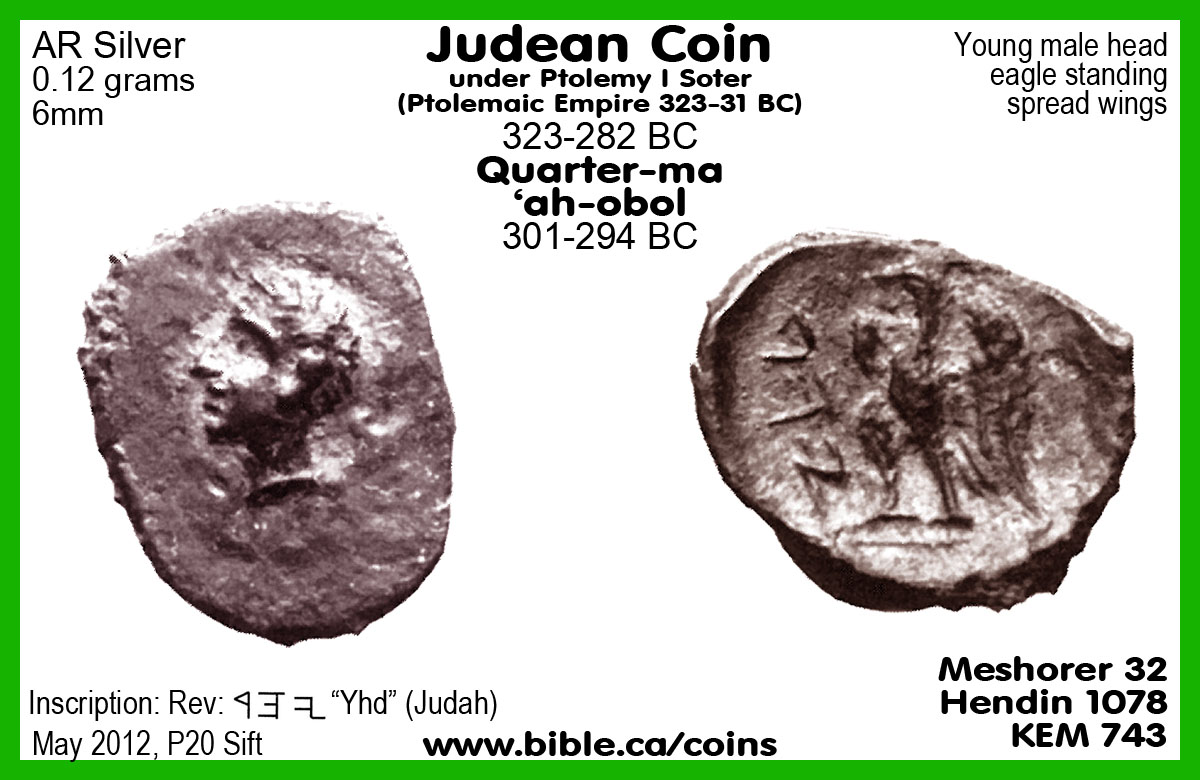
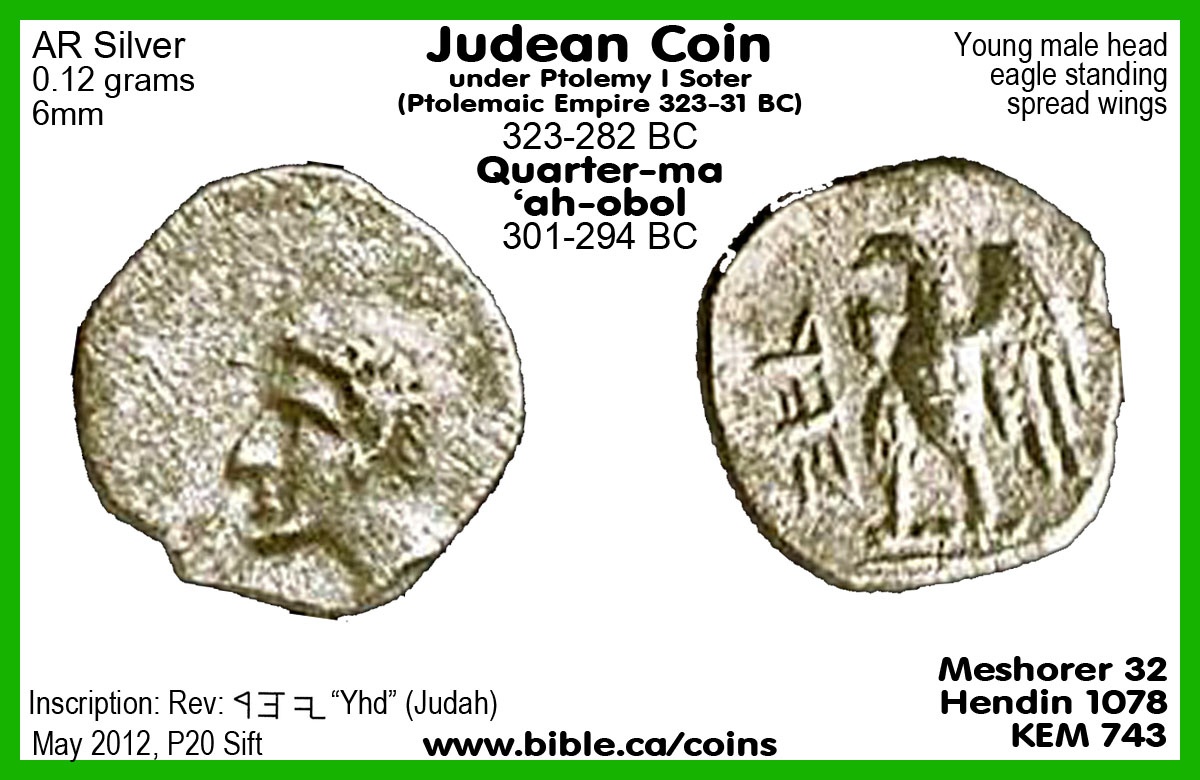
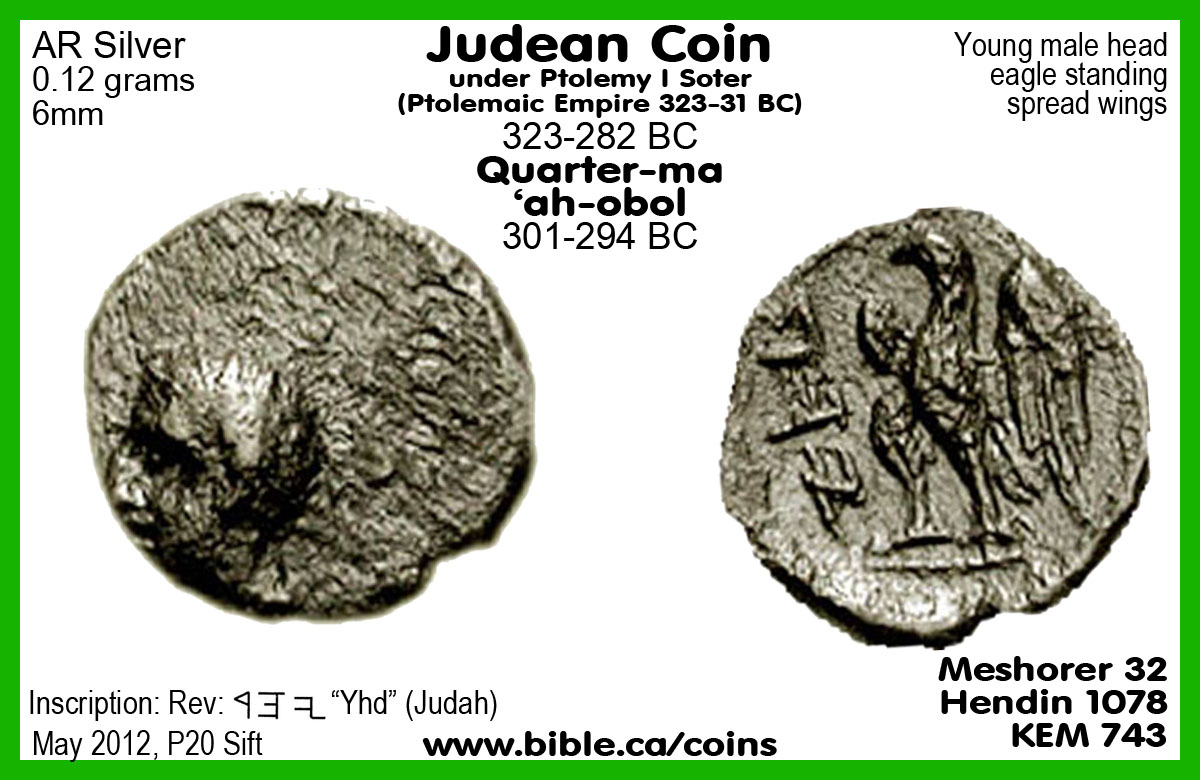
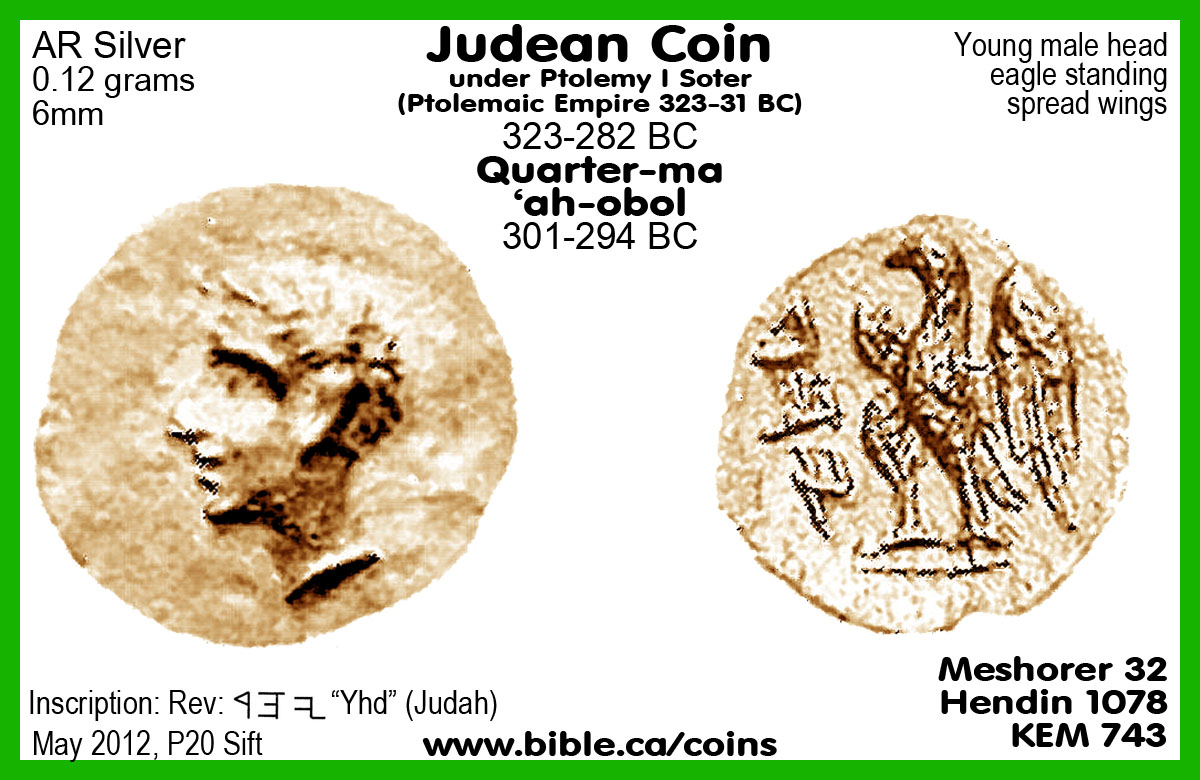
Conclusion:
1. The Greek kingdom existed from 333 - 31 BC
2. Alexander the Great lived only ten years and ruled the world as a sole monarch from 333-323 BC
3. The early Greek/Macedonian period is 333 - 302 BC as far as classifying coins is concerned.
4. After Alexander the Great died, his kingdom was split into four Kingdoms: (Four "horns" empires after Alexander the Great)
- Ptolemy Empire (323-31 BC)
- Seleucid Empire (321-64 BC)
- Cassander (319-168 BC) We do not discuss this kingdom at all because it is far removed from land of Judah.
- Lysimachus (323-133 BC) We do not discuss this kingdom at all because it is far removed from land of Judah.
- For a short time during the Greek Empire period, the Jews gained true independence under the Maccabees (Hasmonean Era): 166-37 BC
- Rome conquered all by 31 BC and the fourth and final kingdom of Daniel's prophecy (Dan 2) came into existence.
- On Pentecost 33 AD, God set up his divine Kingdom which we know today as the Church of Christ which will never come to an end:
- "For this you know with certainty, that no immoral or impure person or covetous man, who is an idolater, has an inheritance in the kingdom of Christ and God." (Ephesians 5:5)
- "For He rescued us from the domain of darkness, and transferred us to the kingdom of His beloved Son, in whom we have redemption, the forgiveness of sins." (Colossians 1:13–14)
- Why not attend a local church that follows the pure Bible Blueprint in your own home town! Click here to find one
|
GREEK EMPIRE COIN PAGES (333-31 BC) |
|||
|
333-302 BC |
323-31 BC |
321-64 BC |
166-37 BC |
|
|
|||
By Steve Rudd: Contact the author for comments, input or corrections.
